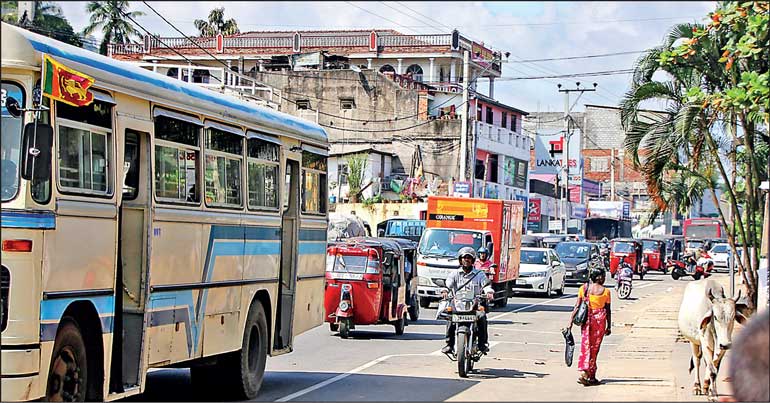Monday Dec 15, 2025
Monday Dec 15, 2025
Wednesday, 1 January 2025 00:20 - - {{hitsCtrl.values.hits}}

Many drivers operate without proper training or valid licenses, undermining road safety
 Sri Lanka’s roads have long been a scene of organised chaos, where three-wheeler drivers, motorcyclists, and bus operators play a prominent role in shaping the traffic landscape. The indiscipline among these drivers not only exacerbates congestion but also contributes significantly to road accidents and fatalities. Addressing this pressing issue requires a multi-faceted approach that combines stricter law enforcement, systemic reforms, driver education, public awareness campaigns, and technological advancements. A collaborative effort involving the government, law enforcement agencies, and the public is crucial to fostering a disciplined and safe driving culture in Sri Lanka.
Sri Lanka’s roads have long been a scene of organised chaos, where three-wheeler drivers, motorcyclists, and bus operators play a prominent role in shaping the traffic landscape. The indiscipline among these drivers not only exacerbates congestion but also contributes significantly to road accidents and fatalities. Addressing this pressing issue requires a multi-faceted approach that combines stricter law enforcement, systemic reforms, driver education, public awareness campaigns, and technological advancements. A collaborative effort involving the government, law enforcement agencies, and the public is crucial to fostering a disciplined and safe driving culture in Sri Lanka.
I. Understanding the problem
Role of three-wheeler drivers
Three-wheelers, or tuk-tuks, are a ubiquitous mode of transport in Sri Lanka. While they offer convenience and accessibility, their drivers often exhibit reckless behaviours such as abrupt lane changes, disregard for traffic signals, and unauthorised parking. A significant portion of three-wheeler drivers lack formal training, with some even operating without valid licenses. This lack of training is particularly prevalent in rural areas, where drivers may not be as familiar with traffic rules and road safety.
In rural regions, access to certified driver training programs is limited, exacerbating the problem. Therefore, it is essential to ensure that three-wheeler drivers, especially in these areas, undergo mandatory training to improve road safety. This can help bridge the knowledge gap and create safer driving practices across the island.
Challenges with bus drivers
Bus drivers, particularly those operating private buses, are another major contributor to road indiscipline. Incentive structures based on the number of trips completed encourage aggressive driving behaviours, including speeding, overtaking in unsafe conditions, and disregarding pedestrian crossings. The rivalry between private buses competing for passengers further aggravates the problem, often resulting in accidents.
To address this issue, it is crucial to revise the incentive models for private bus operators, focusing on safety rather than speed and frequency. Additionally, the introduction of modernised buses equipped with GPS and speed limiters can further support safe driving. By integrating technology with reformed incentive structures, the focus can shift toward both passenger safety and timely service.
Indiscipline among motorcyclists
Motorcyclists, especially those working as delivery personnel for services like PickMe and Uber Eats, contribute to the chaotic road environment. These riders frequently weave through traffic, violate lane discipline, and speed recklessly to meet tight delivery deadlines. Their behaviour not only endangers themselves but also other road users. Lack of adherence to safety measures, such as wearing helmets and proper signalling, further intensifies the issue.
Delivery companies must work alongside authorities to create a culture that prioritises safety over deadlines. Incentivising riders who complete deliveries safely within a reasonable timeframe, rather than rewarding speed alone, would help balance efficiency and road safety. Tightening regulations around delivery pressures will encourage responsible driving practices.
Pedestrian negligence
Pedestrians, too, play a role in the lack of road discipline. Jaywalking, crossing in unsafe areas, and ignoring pedestrian crossings contribute to unsafe road conditions, exacerbating traffic issues.
While educating pedestrians through awareness campaigns is important, improvements to pedestrian infrastructure are equally vital. Building safer pedestrian crossings, overhead bridges, and designated walking zones will create an environment where both pedestrians and drivers can coexist more safely.
Impact on road safety
The consequences of road indiscipline are alarming. According to the National Council for Road Safety, buses, three-wheelers, and motorcycles are involved in a significant proportion of road accidents. Vulnerable road users such as pedestrians, cyclists, and motorcyclists are often the most affected. This culture of non-compliance with traffic rules perpetuates a cycle of indiscipline, affecting all road users.
II. Root causes
1. Inadequate training and licensing: Many drivers operate without proper training or valid licenses, undermining road safety.
2. Weak law enforcement: Traffic violations often go unpunished due to inadequate enforcement and corruption within law enforcement agencies.
3. Systemic incentive structures: Reward systems that prioritise speed and trip frequency over safety encourage reckless driving.
4. Lack of public awareness: Many drivers and pedestrians lack a clear understanding of traffic laws and the consequences of violations.
5. Delivery pressures: Tight deadlines for delivery services contribute to unsafe driving practices among motorcyclists.
6. Neglect of pedestrian safety: Limited awareness and enforcement of pedestrian laws exacerbate unsafe behaviours on the roads.
III. Proposed solutions
1. Stricter law enforcement
2. Systemic reforms
3. Comprehensive driver education
Mandatory training programs: Require all drivers, including three-wheeler drivers, to undergo certified training programs covering road safety, defensive driving techniques, and traffic laws.
Regular assessments: Introduce periodic assessments and license renewals to ensure drivers maintain their skills and knowledge.
School-based education: Incorporate road safety education into school curriculums to instil discipline from a young age.
4. Public awareness campaigns
5. Technological advancements
6. Pedestrian-focused interventions
IV. Role of traffic police
The traffic police are pivotal in implementing these solutions. Their responsibilities should include:
1. Strict monitoring: Conduct regular patrols and inspections to ensure compliance with traffic laws.
2. Capacity building: Provide specialised training for traffic police to handle modern enforcement technologies.
3. Collaboration with stakeholders: Work closely with government agencies, NGOs, and community organisations to promote road safety initiatives.
4. App integration: Utilise the proposed mobile application to streamline fine collection and enhance transparency.
V. Proposed system for reporting road indiscipline
To encourage public participation in maintaining road discipline, a new system should be introduced where citizens can anonymously report instances of road indiscipline. This can be done through a mobile application or a website that allows individuals to upload videos or images of traffic violations. The submissions will be reviewed by relevant authorities, such as the traffic police or the Department of Motor Traffic, to take necessary action. The system should ensure anonymity to protect the identity of the reporter and maintain trust in the process. This initiative will not only increase accountability but also provide a sense of shared responsibility among the public for maintaining road safety.
Conclusion
The chaotic indiscipline among Sri Lankan drivers is a deeply rooted issue that requires immediate action and presidential leadership. Throughout this article, we have highlighted the alarming behaviours of three-wheeler drivers, bus operators, motorcyclists, and pedestrians, which not only contribute to congestion but also endanger lives on our roads. The proposed solutions—ranging from stricter law enforcement, revised incentive structures, and comprehensive driver education to technological advancements and pedestrian-focused interventions—offer a roadmap to address these challenges.
However, the implementation of these solutions demands bold leadership from the highest level. It is a call for the President to take decisive action, ensuring that these reforms are put into practice swiftly and effectively. The need for an integrated approach, where law enforcement, education, public awareness, and technological innovation work in tandem, cannot be overstated. It is only through coordinated efforts, led by presidential leadership, that we can break the cycle of road indiscipline and build a safer, more responsible driving culture in Sri Lanka.
We humbly plea to the President to not only consider the proposed solutions but also explore additional measures that may be necessary to address this growing crisis. The lives of countless Sri Lankans depend on the swift and comprehensive action that only the leadership of the President can provide. The time for change is now, and we look to the President to lead us toward safer, more disciplined roads for all.
(The writer is a seasoned operations director, consultant, and writer, equipped with a diverse range of experience across fields such as business management, education, consultancy, and journalism.)